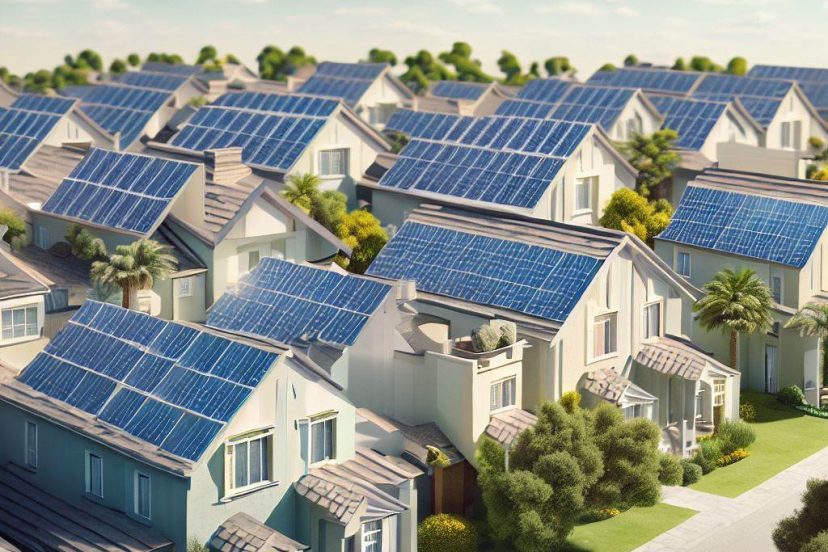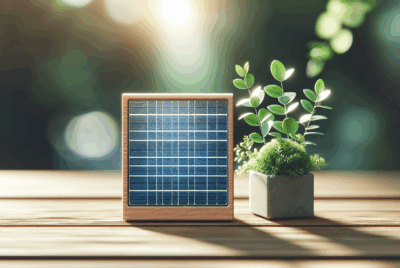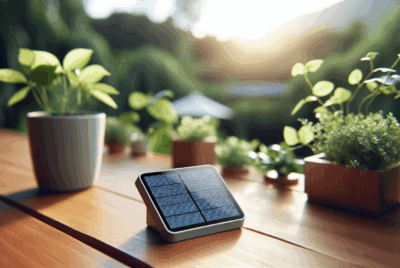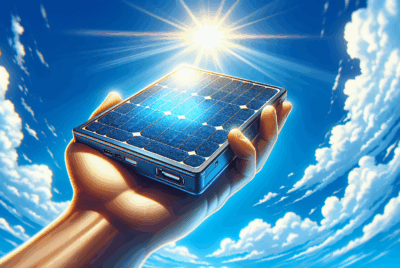Solar Panel Cost: Shining Light on Solar
As an Amazon Associate, I earn from qualifying purchases, at no additional cost to you. Disclaimer
Introduction
If you’re someone who’s never really thought about the energy that powers your home, the idea of trying to understand solar panel cost might seem like jumping off the deep end. A lot can play into the decision to take on a solar project, but it’s not as complex as it might first appear, and the benefits are truly substantial. Let me share some insights I’ve gained as I worked towards living on solar power.
Remember the time you first started recycling or made a conscious choice to reduce your plastic usage? Solar panels are another, even more significant step in that same direction. They harness the energy of the sun, a natural and renewable source of power, to provide electricity for your home. Unlike fossil fuels, they don’t produce harmful emissions or contribute to climate change. That’s a big win for our planet!
Solar panels offer you an opportunity to contribute to a more sustainable future, save money on your energy bills, increase your energy independence, and join a vibrant community.
Understanding Solar Panel Cost
When I first contemplated switching to solar power, I must admit, the associated costs seemed rather expensive. But as I navigated through the process, I realized the importance of understanding the intricacies of solar panel costs. Let me share some of what I learned with you.
Initial Investment
Let’s address the elephant in the room – the upfront solar panel cost. A solar panel system does require an initial investment, which typically includes the cost of the panels, inverter, batteries, wiring, and installation. The exact cost can vary widely depending on the size and type of the system, as well as your geographical location. When I first got quotes for solar panels, I was taken aback by the numbers, but remember this – the initial cost should be considered an investment rather than an expense.
To get a clear understanding of the cost, it’s a good idea to get several quotes from different providers. This way, you can compare costs and services, and make a more informed decision. I spent a considerable amount of time doing this and even learned to negotiate prices, which helped reduce costs significantly.
Running Costs
Once your solar panel system is up and running, you’ll find that the ongoing costs are significantly less than those associated with traditional power sources. Maintenance for solar panels generally involves occasional cleaning and checking for any physical damage, especially after a storm. Apart from this, solar panels require little to no upkeep, and the sunlight that powers them is absolutely free!
When I considered the running solar panel cost, I found that the monthly energy savings more than made up for the upfront investment over time. The electricity bill that once ate up a significant chunk of my budget reduced dramatically. And as energy prices continue to rise, my solar panels shield me from these increasing costs.
Also, remember that many solar panels come with a warranty – often as long as 25 years. This means that if something does go wrong, you may be covered. I strongly advise you to carefully review the warranty conditions when choosing your solar panel system.
In essence, understanding the costs associated with solar panels involves more than just looking at the initial price tag. It’s about assessing the long-term benefits, the potential savings, and the positive impact on our environment.
Types of Solar Panels
As someone who was once a beginner to the world of solar energy, I can tell you that understanding the different types of solar panels was an exciting part of my journey. Each type has its own pros and cons, and choosing the one that best suits your needs can significantly impact the effectiveness and cost of your solar system.
Monocrystalline
When I first started researching solar panels, I was amazed to learn about monocrystalline panels. These panels are made from a single, pure crystal structure, which makes them highly efficient. In simpler terms, they can convert a larger amount of sunlight into electricity compared to other panel types.
However, this high efficiency comes at a cost, making them the most expensive type of solar panels. I found them to be a great option for those with limited roof space, as their high efficiency means you need fewer panels to generate the same amount of power.
Polycrystalline
Polycrystalline panels are less efficient but also less expensive than monocrystalline panels. They’re made from multiple crystal structures, which gives them a unique, speckled appearance.
Although they require more space to produce the same amount of electricity, they can be a more cost-effective option. I’ve found them to be a good middle-ground solution, offering a balance between efficiency and price.
Thin-film
Next, let’s talk about thin-film panels. These are the least expensive and least efficient panels. But don’t let that deter you. Their easy production process and flexibility open up exciting installation possibilities.
For instance, they can be installed on surfaces that aren’t suitable for other types of panels, like curved roofs. I’ve even seen them on carports and garden sheds! Their affordability and versatility make them an excellent choice for large-scale installations or for those on a tighter budget wanting to keep overall solar panel cost down.
BIPV Panels
Finally, we have Building-integrated photovoltaics (BIPV) panels. These are integrated into the building materials themselves, replacing components like the roof, windows, or façade. Although they can be more expensive, they offer aesthetic and space-saving benefits.
When considering a new roof for your home, BIPV panels are an interesting option. They allow you to incorporate solar into the very structure of your home, which not only looks sleek but also saves roof space. As both pricing and efficiency continue to improve, this may eventually become common building practice in many parts of the country.
Understanding the different types of solar panels helped me make an informed decision about which type was right for me. By considering factors such as cost, efficiency, available space, and aesthetics, you can choose the type of solar panel that best fits your home and lifestyle.
Factors Affecting Solar Panel Cost
Before I took the plunge into solar energy, I was shocked by the variety in prices for solar panel systems. This price difference can be attributed to several key factors, and understanding these helped me figure out which system would fit my budget without compromising my energy needs.
Size of the System
It’s straightforward—larger systems with more panels cost more. The size you’ll need primarily depends on your household’s energy consumption.
When you start planning for your solar installation, I suggest reviewing several months of your electricity bills to estimate your daily energy usage. Remember, your goal should be to match your usage with the production of your solar panel system, so this step is crucial. Even if you start small, matching part of your usage is great. You can always add to the system over time if you want to minimize your solar panel cost in the beginning.
Quality of the System
Just like with any other product, higher quality solar panels usually come with a heftier price tag. They are often more efficient, durable, and come with better warranties. I weighed these benefits against the solar panel cost to find a level of quality that was within my budget but also met my long-term energy needs.
Type of Solar Panel
As discussed earlier, the type of solar panel—monocrystalline, polycrystalline, thin-film, or BIPV—affects its cost. Your choice here would be based on your budget, roof space, and efficiency needs.
Installation Complexity
The complexity of your installation can impact labor costs. For example, a roof with a steep slope or unique architecture may require more work to install panels on. In my case, I had to account for the additional cost of reinforcing my roof to handle the weight of the panels.
Optional Extras
Adding optional extras like a solar battery or an advanced inverter can increase the price. I initially decided to skip the battery to cut costs, but after experiencing a few power outages, I decided to add one to my system for energy storage.
Location
Geographical location impacts solar panel cost due to variations in installation prices and the amount of sunlight received. While we can’t control this factor, taking full advantage of local government incentives and rebates can help offset the costs.
Analyzing these factors allowed me to navigate the diverse world of solar panel costs and understand where my money was going. This detailed consideration led to more informed decision-making and ultimately a solar panel system that was customized to my specific needs and budget.
Benefits of Solar Panels
Switching to solar energy was one of the most rewarding decisions I’ve made, and I’d love to share the multifaceted benefits that came along with that decision. Whether it’s the financial advantages, the environmental impact, or the gratification of self-sustainability, the benefits of solar panels are well worth considering.
Financial Savings
This benefit is often the most attractive one, and for a good reason. Despite the upfront solar panel cost, they can lead to substantial savings over time. Once I had my system installed and running, I saw a significant reduction in my monthly electricity bills. With solar panels, you essentially become your own energy producer, and that feeling of not having to rely entirely on the grid for power is liberating.
Environmental Impact
Switching to solar power means adopting a clean, renewable energy source. It’s a tangible step you can take towards reducing your carbon footprint. When I think about my solar panels, I like to picture them as my little warriors fighting against climate change, transforming sunlight into electricity without producing harmful emissions. It is really a source of pride for me, knowing I am doing my part to make this a better place for future generations.
Energy Independence
Solar panels provide a degree of energy independence that’s hard to achieve with traditional power sources. If your system includes a battery, you can store excess energy for use during the night or on cloudy days. This came in handy for me during a few unexpected power outages. It felt good to know that I could still have some lights on even when the rest of the neighborhood was in the dark. It feels even better when I invite them over to ride out the storm with us.
Increasing Property Value
If you’re a homeowner like me, you’ll appreciate this one. Solar panels can increase the value of your property. When it came time for me to refinance my home, the appraiser took into account my solar installation, and it had a positive impact on my home’s overall value. As more people become environmentally conscious, properties with solar installations are becoming increasingly attractive.
Government Incentives
One of the things that initially drew me to solar panels were the incentives offered by my local government. Depending on your location, you might qualify for tax credits, rebates, or other financial incentives that can offset the initial installation cost. I highly recommend checking what’s available in your area and then work with your accountant during tax season to make sure you get the appropriate credit.
Maintenance and Durability
Finally, one of my favorite things about solar panels is their durability and low maintenance. Once installed, they require little upkeep. They’re designed to withstand harsh weather conditions, and most come with a long-term warranty. Just an occasional cleaning and a professional check-up now and then, and you’re good to go.
From financial savings to playing a part in the fight against climate change, the benefits of installing solar panels are numerous and far-reaching. It’s an investment that pays off in more ways than one, contributing positively to your life and the planet.
Potential Drawbacks and Challenges to Solar Panel Cost
While my journey into solar power has been overwhelmingly positive, it’s only fair to talk about the potential drawbacks and challenges as well. From the initial solar panel cost to the reliance on weather, here are some things you might want to consider before making the switch.
Upfront Costs
The initial cost of solar panel systems is often the biggest hurdle for many people, myself included. The panels, along with the inverter, batteries, and installation, can add up. But remember, these costs should be viewed as an investment. They lead to significant savings in the long run and contribute to a more sustainable future.
Dependence on Weather
Solar panels need sunlight to produce energy, so their effectiveness can be influenced by your local weather. I live in a relatively sunny area, so this wasn’t much of an issue for me. But for those living in areas with less sunlight, this could be a challenge. On the plus side, solar technology is continually improving, and modern panels can still produce power even on cloudy days.
Roof Suitability
The suitability of your roof can also be a potential challenge. If your roof is heavily shaded, or if its shape, angle, or direction is not ideal, it could affect the efficiency of your panels. In my case, I had to prune a large tree to reduce shading on my roof. Take a quick peek just to be sure there aren’t any trees or neighboring homes that cast a shadow. And usually a south facing roofline will provide the most direct sunlight year-round.
Space Requirements
Given the space that solar panels need, this could be a drawback for those with smaller roofs. When planning for installation, you will need to consider both the current and future energy needs of your household to make sure there is enough roof space for the required number of panels.
Aesthetics
While I personally find solar panels to be quite sleek, and make a statement about the importance of energy independence, some people might not like the look of them on their roofs. This is really a personal preference, but it’s worth considering if the aesthetics of your home are a priority for you.
Taking the time to understand and anticipate these potential challenges will help you make a more informed decision. With the right planning and consideration, many of these can be mitigated. For me, the benefits of solar power have far outweighed these potential drawbacks.
Keeping Solar Panel Cost As Low As Possible
Shop Around and Negotiate
Just as with any large purchase, shopping around and comparing prices from different vendors can lead to savings. When I was looking for my solar panel system, I got quotes from multiple companies and was surprised by the variation in prices. Don’t hesitate to negotiate either—I managed to get a lower price by discussing my budget limitations with the vendors. How about the last time you were at Costco? There is usually someone back by the electronics, or on my way out towards the receipt checkers.
Start Small
If the total cost of a complete solar system is too high, consider starting small. You can begin with a few panels and gradually add more as your budget allows. This was the route I took. Starting small helped me offset a portion of my electricity bill immediately, and as I added more panels, my savings grew. Please don’t feel like you have to go all in at once.
Invest in Energy Efficiency
Before installing solar panels and making the switch, I took steps to reduce my overall energy usage by investing in energy-efficient appliances and lighting, and by improving the insulation in my home. This lowered my energy requirements, meaning I needed fewer solar panels, which, in turn, reduced the cost of my solar system. Even this step made me feel good about reducing my carbon footprint, and actually motivated me to keep looking for new ways to save energy.
Do Some Tasks Yourself
Certain aspects of going solar, like energy audits or simple maintenance tasks, can be done yourself. When I decided to go solar, I conducted a preliminary energy audit of my home. While not as comprehensive as a professional audit, it helped me understand my energy usage better and saved me some money. This also helped me feel more confident when I spoke with the pros, since I could share my knowledge and better understand their questions.
Community Solar
If installing solar panels on your property isn’t feasible due to cost, space, or other restrictions, consider joining a community solar project. These programs allow you to purchase a share of a larger solar farm located in your area. I have a friend who went this route when he found that his roof wasn’t suitable for solar panels, and he’s been happy with the savings on his electricity bills. This might take a bit of research; check with your local government to see how you can take part.
Conclusion
Going solar is a significant decision. While it does require an initial investment, the benefits, both financially and environmentally, can be substantial. With careful research and planning, you can make the most of your solar panel investment. Exploring some of the strategies I’ve shared can help make going solar more affordable. Each situation is unique, so consider your personal circumstances and decide which options are best for you. The road to solar power may have an upfront cost, but the transition can lead to impressive savings and a more sustainable future.
Frequently Asked Questions (FAQs)
1: How much does a solar panel system cost on average?
The cost of solar panels can vary widely depending on several factors, including the size and type of the system, your location, and any local incentives available. A typical residential solar panel system in the United States can range from $15,000 to $25,000 before incentives.
2: Are there financing options for solar panels?
Yes, there are several financing options available for solar panels. Many solar companies offer leasing and power purchase agreements (PPAs), where you don’t pay for the solar panels upfront but make monthly payments instead. Additionally, some banks and credit unions offer green loans specifically for renewable energy projects.
3: How long does it take for solar panels to pay for themselves?
The payback period for solar panels – the time it takes for energy savings to cover the cost of the system – can vary based on the cost of the system, the cost of electricity in your area, the amount of sunlight your panels receive, and any financial incentives you benefit from. On average, it can take anywhere from 7 to 20 years.
4: Can I install solar panels myself to save on installation costs?
While it’s technically possible to install solar panels yourself, it’s generally not recommended unless you have relevant experience. Installation involves electrical work that can be dangerous if not done properly, and an incorrect installation can also reduce the effectiveness of your panels or even damage your roof.
5: How do I know if my roof is suitable for solar panels?
Several factors can determine if your roof is suitable for solar panels. These include the direction and pitch of your roof, the amount of sunlight it receives, the condition of the roofing material, and the amount of space available. A solar panel provider can perform a site assessment to determine if your roof is suitable. Generally, south-facing roofs with a pitch of around 30 degrees that get little shade are ideal.




